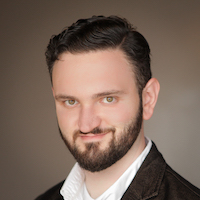Running Facebook ads can be a total game changer for your book career, but it can also be a big waste of time and money if you don’t know what you’re doing. Over the last few years, we’ve worked with a ton of authors and publishers, but one question we get almost daily is this: “Is running ads on Facebook the same thing as boosting a post?” I’d like to give a very Facebook answer and say, “it’s complicated.” (Read on, it’s really not that complicated.)
To the naked eye, ads and boosted posts look the same—your readers will barely be able to tell the difference—but to you (the person purchasing the advertisement), they are quite different.
The major advantage of boosted posts is that they’re really easy to create, it only takes a few clicks. You can also capitalize on a Facebook post that has already performed well organically. Facebook ads, on the other hand, are more difficult to create, but they are also much more powerful.
Facebook Ads and Boosted Posts Differ in 4 Primary Ways:
- Targeting
- Creative
- Campaign goals
- Costs
Targeting Options
One of the key differences between boosting posts and running ads through Facebook's ad platform is the myriad ways you can target different audiences. Boosting posts is designed for quick and dirty campaign creation, whereas the ad platform offers a number of advanced targeting methods designed to pinpoint specific people, right where you want to reach them.
Boosting a post offers three primary methods of targeting:
- people who like your page (i.e. your existing readers)
- friends of people who like your page (i.e. your extended network of potential fans, connected to your existing readers)
- broad demographic targeting (i.e. reach a huge group of people along age, geography, and gender guidelines).
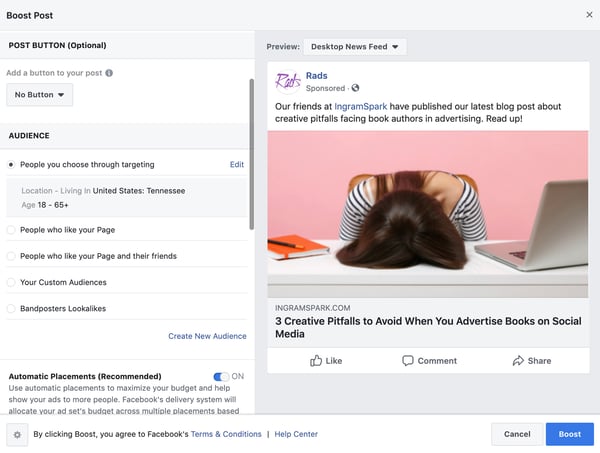
This targeting can be quite effective—if you have a specific message you're trying to convey in an existing post, boosting is a great way to show that to some extra eyeballs. You can quickly throw a couple bucks behind your organic views, and reach an extended network of people who may very well be interested in your work.
So what about those custom audiences and interest-based targeting?
This is where Facebook's ad platform really excels. Rather than targeting people who already like your books, you can narrow in on extremely specific audiences who are likely to enjoy your work.
Let's say, for instance, that you write popular science books about string theory, and you write in English and haven't translated your work. Your existing readers are well-educated, typically have expendable income, mostly read on digital platforms, and you know a handful of similar authors that your readers also like.
Through Facebook ad platform, your targeting might look like this:
- Age: 22-55
- Gender: Male and Female
- Geography: United States, Canada, United Kingdom, Ireland, Australia
- Language: English (All)
- Similar authors: Brian Green, Carl Sagan, Michio Kaku, Neil deGrasse Tyson, Richard Feynman, Stephen Hawking
- Other: Kindle owners, college degree or higher
Here's what it looks like when you're building your ad:
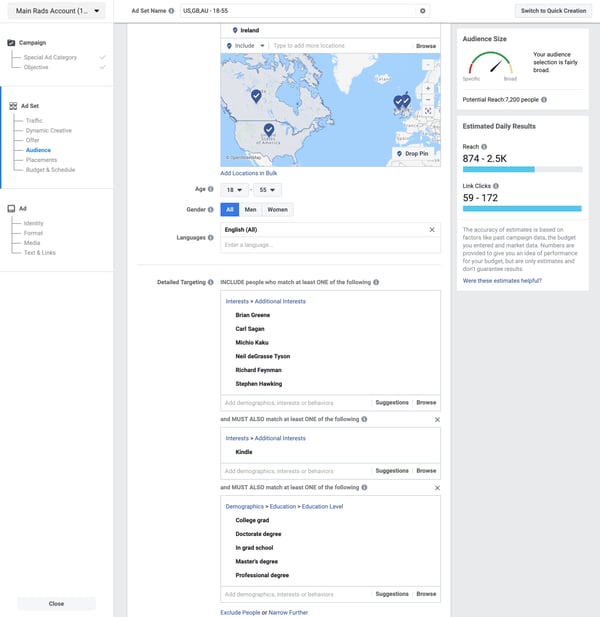
And it gets even more granular than this. You can target along device types (e.g. only iPhone users), marital status (great for authors writing books about getting married, divorce, self-help, etc.), politics, interest in sports (would you believe that soccer actually has its own targeting category inside of Facebook?), and about a zillion other things.
Herein lies the real power of Facebook's ad platform, and most of these options don't really exist if you're only boosting a post.
Creative Options
When you boost a post, your ad creative is very simple. It's just your original post, sometimes with an extra call-to-action button. This of course means you are limited to only the standard types of posts Facebook allows on your page: text posts, image posts, link posts, and video posts.
To the reader, these ads look just like any other type of post that comes from your page. They show up in the feed only, and they're mostly indiscernible from the other content you post, apart from a little note that says "Sponsored."
Contrast this with the wide array of ad types available through Facebook's platform:
- carousels
- canvases
- vertical video in Facebook and Instagram stories
- sidebar ads, collections (for products)
- and of course, all the other standard post-type ads
Not only are all of these available, but you can specify which ones you want to use, and even use some of them in combination with others.
Here's what a carousel ad might look like, which allows for multiple books to be advertised at once:
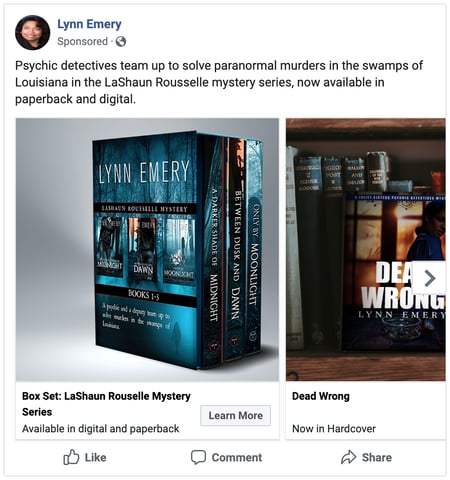
If you were to simply boost a post, you'd be limited to a single image or video, much like any other organic post on Facebook. Instead, you'd have to post something like this:
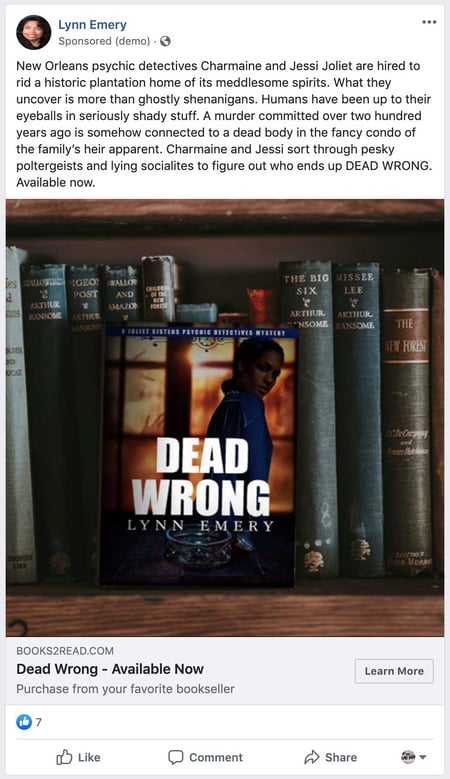
This is not inherently a bad thing—in fact, in many cases, this type of ad works better—but it does limit the flexibility of your advertising, and ultimately in the way you present your brand and your work.
Campaign Goals
One of the biggest differences between Facebook ads and boosted posts is the way in which the success of your ads is measured. And, as it happens, this also affects the way in which you pay for your ads—all online ad platforms are priced based on success metrics, and there are many of them to consider.
Boosted posts are priced based on impressions. That's the number of people who are served and/or view your advertisement, regardless of whether they click or take any further action.
Many of these users may take actions, such as clicking, sharing, commenting, etc., but the boosted post platform only charges you based on how many people are seeing your ad. This dramatically simplifies the price structure, but also limits the effectiveness of these ads in driving specific results.
For instance, let's say your ultimate goal is to have people download a sample of your book.
If you're just paying for impressions, you can roughly estimate the cost of this goal by taking your total spend, and dividing by the number of downloads you received. So let's say you spent $100 and got 50 downloads. That's $2 per download.
Is a book sample download worth $2 to you?
Let's assume for a moment that 1 of every 20 sample downloads results in a sale of that book, and the sale results in $10 back to you. Well, in that case, it would require $40 just to get $10 in book sales, and that doesn't make much sense at all.
Facebook ads allow you to optimize for a bunch of other metrics, including clicks, engagements, e-commerce sales, and even offline events (like a customer walking into a brick-and-mortar store).
And here's where things get really interesting.
In the above example, if 1 out of 20 sample downloads results in a $10 sale, then you need to optimize the price of a sample download to be $0.50 or better. This is where custom conversion-based ads come in. Using Facebook's advanced tracking pixels, alongside conversion-based ad pricing, you can just tell Facebook's ad system that you want to pay $0.50 or better per download and they'll automatically optimize your ads to hit that goal!
There's a catch, of course (isn't there always a catch with this sort of thing?). Setting this process up is difficult, and requires compatible technology, and a working knowledge of setting up Facebook pixels for custom conversion tracking. The main point of this example is only to demonstrate just how powerful the Facebook advertising platform is in comparison to boosted posts. But there are many other ways you can use these tools (or you can rely on a trusted third party like Rads to do it for you).
Cost
Digital ad pricing is one of the most confusing and complicated questions we get asked. And inevitably I boil my answer down to this:
You can spend as much or as little as you want to spend.
If you think about the price of buying a billboard, typically that price is set by the billboard company. They might base this price on the location of the billboard, the number of cars that pass by each day, the size of the billboard, etc. But at the end of the day, they usually just list out the price: this one is $4,000, this one is $10,000, and so forth.
Digital ads work very differently. As I mentioned above, the price is determined by the number of results you hope to achieve. So an ad might be priced at $5 per thousand impressions (this is called CPM pricing), but if your ad receives exactly 145,049 impressions you'll be charged $725.24.
Both Facebook ads and boosted posts share a common feature, though, and that is budgeting.
Rather than setting your desired CPM, you set a total budget.
- For boosted posts, you can set a total budget and the number of days you'd like your ad to run. Those are the only options.
- With Facebook ads, you can set daily budgets, pro-rated budgets across ad sets, campaign budgets (which automatically optimize across many ads and targeting methods), and more. There is significant flexibility here.
Moreover, you can optimize your ads and targeting on the fly with Facebook ads in order to drive the cost of your ads down (or up!). With a boosted post, you don't really have the option to change anything about the ad once it's running.
The differences between boosted posts and Facebook ads can be a bit complex, but it's not really as complicated as it might seem. With careful design, a whole lot of elbow grease, and a firm knowledge of the platforms, tools, and features of these different ad types, you can achieve exactly the results you were hoping for with your digital marketing dollars.



